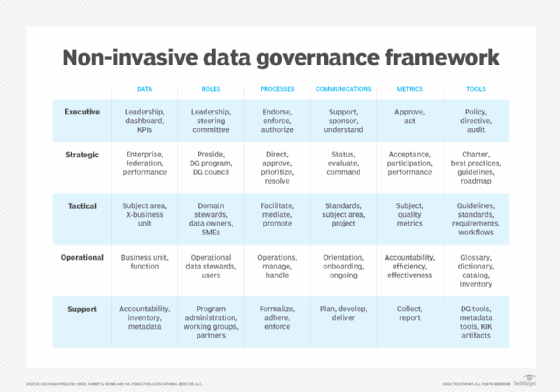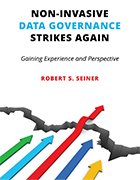Why noninvasive data governance is the best approach to use
Organizations typically approach data governance with top-down or traditional approaches. Consultant Robert Seiner discusses what makes his noninvasive approach the best option.
Organizations that use data, advanced analytics or AI need a data governance program. Consultant and author Robert Seiner says the best approach is noninvasive data governance.
Seiner has spent two decades working on data governance. As the president and principal of Kik Consulting, he works with organizations to solve their governance issues and implement his noninvasive data governance framework.
Seiner published his first book, Non-Invasive Data Governance: The Path of Least Resistance and Greatest Success, in 2014, and introduced a new way for organizations to consider structuring data governance. Noninvasive data governance focuses on formalizing accountability that existing roles might already have, rather than restructuring duties and potentially adding responsibilities to employees' workloads.
Since publishing his first book and helping organizations around the world implement his framework, he's learned new lessons and perspectives on the data governance issues organizations face. He published a second book -- Non-Invasive Data Governance Strikes Again: Gaining Experience and Perspectives -- in 2023 to share these insights and the framework noninvasive data governance needs to succeed.
Seiner spoke with TechTarget Editorial about what separates noninvasive data governance from other data governance approaches, why his framework is key to the success of data and analytics operations, and the effect of generative AI on data governance.
Editor's note: The following interview was edited for length and clarity.
How is noninvasive data governance different from other data governance approaches?
Robert Seiner: There are three approaches organizations can take to data governance. There's the command and control, top-down approach, where everybody is assigned new roles and where it feels brand new to the organization. There's a traditional approach which follows the idea of the movie Field of Dreams -- 'if you build it, they will come' -- organizations build an approach to data governance, and hope people will gravitate toward it. Then there's a third approach, my non-invasive approach. This approach assumes there are already levels of accountability in the organization, and it focuses on formalizing that accountability rather than handing it to people as something that's brand new to them. It's a lot less threatening. … Instead of assigning people something new, this approach recognizes people for their relationship to the data and helps them to govern more effectively without intentionally adding significantly to what they are already doing.
Is noninvasive data governance the main approach that organizations use now, or are they using the others more?
Seiner: I would say most organizations still follow the traditional approach; they build a program and hope people will gravitate toward it. There are a lot of organizations that tell me the only approach that will work for them is if they stay non-invasive. People are often already busy more than 100% of the time, and if they feel you're adding to their work effort, they're going to push back. There are a lot of organizations that come to me and say, 'we need to have a data governance program and non-invasive is the approach we need to follow.' As people continue to learn about it, there seems to be more and more interest in it.
What's the biggest challenge organizations run into when trying to adopt noninvasive data governance?
Seiner: The biggest challenge is applying the necessary resources toward it. I've talked to several organizations that think by creating a data governance program it's going to run itself. There need to be resources associated with implementing data governance and with metadata management. It's very hard to govern your data without metadata documentation.
The organizations doing better than others are the ones that are applying resources to their efforts. There are still a lot of organizations having a hard time finding resources to apply toward data governance, which is surprising because organizations should expect that the program is not going to run itself. … The biggest hurdle, and thus greatest challenge, is at the highest level of the organization where they often still don't recognize why they need this.
I always use the expression 'the data will not govern itself.' Governance requires people with knowledge about the data to govern it. The metadata will not govern itself. The program will not run itself. Data governance is the execution and enforcement of authority over data and data management assets. It doesn't matter what approach you take to data governance. At the end of the day, you need to execute and enforce authority or people won't follow the standards, policies and rules. … The question is what approach you want to use.
How difficult is it to implement the noninvasive data governance framework you diagram in Chapter 1?
Seiner: With the framework I share in the book, you shouldn't try to implement it all at one time. I suggest that organizations find the parts of the framework where [they] need to focus. The framework is designed to match the core components with the perspective of the organization. For example, it is necessary to describe roles of the executives, the roles of the tactical and the operational people. And it will be necessary to document metrics that are going to appease the strategic and support levels of the organization. Organizations need to know all of the information collected in the framework at some point. It's not difficult to implement the framework if you're structured in your approach to using it. If you try to embrace it all at one time, especially if you don't have a good plan for how to do that, it's going to be more difficult.

It's difficult to discuss data and analytics topics without mentioning generative AI. How large an impact do generative AI and large language models have on data governance responsibilities going forward?
Seiner: Yes, AI is going to highlight the importance for governance as much as anything else that has come before it. The same level of governance that can be applied to your data warehouse, analytical platform, must be applied to AI and large language models. So, you've got to put controls around the data, and there are challenges associated with that. You can't let just anybody ask what the salaries of executives are and get an answer. As an example, there will need to be restrictions on what people can see and use.
There also needs to be an understanding of how we can effectively use AI. Generative AI became mainstream in November 2022. It is still a growing discipline and science. And it will only become a more and more valuable tool. We need to put the controls around the data. Organizations that understand their data has to be governed will have a leg up on those just getting started now.
And if you're not adopting generative AI or LLMs right now, it doesn't mean data governance is any less important to you?
Seiner: It absolutely does not mean that you need data governance less. Most organizations are at a point where they're beginning to think about large language models and deploying generative AI, but most large organizations haven't started down that path yet. Any organization that wants to assure their data is being protected, shared, following regulatory concerns, that it's not duplicated, that there's high quality data, needs data governance. AI is just another application. It may feel like it's more, but it's truly another application of putting protection and controls around that data. As people become more reliant on AI, it will be the data behind the AI that makes or breaks their use of AI.
If it raises awareness for data governance, that's a good thing. If it raises the awareness of non-invasive data governance, that's an even better thing.
Are there any final comments you'd like to make?
Seiner: The name of the second book is Non-Invasive Data Governance Strikes Again. It's not a second edition of the first book. ... It contains 50 essays that focus on lessons learned and perspectives I've gained from using this approach in organizations around the world. The book is an easy read. You may not want to read it straight through. You may find a subject of interest to you and go right to it. It is truly lessons learned in non-invasive data governance. The name is a dichotomy of sorts. The title alludes to the fact that non-invasive data governance has struck already -- in the form of the first book. Non-invasive and striking anything are at the opposite ends of the spectrum. If anybody has any questions about the book, they should reach out to me at [email protected] and I'll be happy to answer their questions.
Peter Spotts is the site editor for SearchBusinessAnalytics and SearchDataManagement, writing and managing content on both sites. Prior to joining TechTarget in July 2021, Peter worked for Turley Publications in Palmer, Mass., as both a staff writer and editor covering local events and news for six years in Western Mass.








